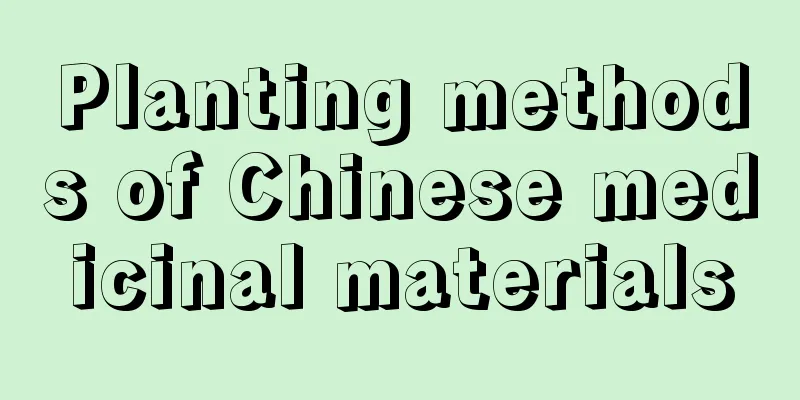Planting methods of Chinese medicinal materials

|
The cultivation of Chinese medicinal materials is a very popular planting project nowadays, and many regions have carried out the cultivation of Chinese medicinal materials . There are many varieties of Chinese medicinal materials, so what are the specific methods of growing them? Let’s learn more about it below. 1. Conventional planting Large-scale and standardized planting is carried out in fields, land, slopes, etc. Most Chinese medicinal materials are suitable for growing in soil with deep soil layer, good fertility and neutral pH. Roots and rhizomes are suitable for planting in sandy loam. 2. Interplanting of crops Intercropping of Chinese medicinal materials with other crops can make full use of natural resources such as land, light energy, air, water and fertilizer, give play to marginal effects and mutual benefits between plants, and effectively resolve the conflicts over land among grain medicines, fruit medicines and forest medicines. Medicinal materials suitable for planting on the edge of fields include honeysuckle, licorice, cassia seed, acne, atractylodes, schisandra, papaya, fenugreek, polygonatum , astragalus, safflower, gentian, and rhubarb. Intercropping of tall and short stalks, such as corn, sorghum, sugarcane, cotton, etc., which have tall stalks and can provide shade, can be intercropped with isatis root, angelica dahurica, platycodon, ligusticum chuanxiong, atractylodes macrocephala, salvia miltiorrhiza, belamcanda chinensis, coix seed, bupleurum, pinellia, pseudostellaria , coptis chinensis, coral grass , and amomum villosum. Deep root system and shallow root system are intercropped. The crop varieties of this model include winter melon, pumpkin, sweet potato, potato, soybean, etc., and the Chinese medicinal materials planted in combination include licorice, honeysuckle, astragalus, platycodon, atractylodes, angelica, safflower, yam, coix seed, papaya, anemarrhena, ginger, and saffron. 3. Interplanting under forest Intercropping in orchards and woods can increase land yield. Among the Chinese medicinal herbs suitable for planting under forests, ginseng is one that mainly grows under mixed coniferous and broad-leaved forests or deciduous broad-leaved forests with a canopy density of 0.7 to 0.8. There is also epimedium, which is suitable for planting under broad-leaved forests, mixed coniferous and broad-leaved forests and fruit economic forests. In addition, there are also asarum and so on. Like peaches, cherries, grapes, persimmons, apricots, etc., you can plant medicinal plants that like shade and humid environments, such as asarum, gastrodia, pinellia, ganoderma, coptis, Panax notoginseng, arisaema, and polygonatum. Fruit trees with sparse crowns, such as apple, pear, hawthorn, etc., can be planted with medicinal plants such as American ginseng, salvia miltiorrhiza, lily, and asparagus. 4. Chinese medicinal materials + sightseeing tourism Large-scale planting can realize tourism and drive the development of surrounding economic cycles. For example, Neiqiu has vigorously built a Chinese medicinal material flower sea base that integrates centralized medicinal material planting and sightseeing tourism, and guided farmers to develop the planting of Chinese medicinal materials such as blackheart coneflower, Platycodon grandiflorum, and Scutellaria baicalensis. In addition, Dongguan County has implemented the development model of "Chinese medicinal materials planting + sightseeing tourism", promoted the standardized planting and mechanized harvesting of Chinese medicinal materials, and guided local farmers to plant the Chinese medicinal material peony. The peony flowers are in full bloom, attracting tourists to enjoy the flowers. 5. Chinese medicinal materials + garden beautification Planting in nursing homes, farmhouses, farms, etc. beautifies the courtyards and forms differentiated competition with peers. For example, Binglang Village in Pengzha Town has a long history of growing Chinese medicinal herbs and has accumulated rich experience. In recent years, the village has combined actual conditions and vigorously guided the masses to develop courtyard Chinese medicinal herb planting, further broadening the people's ways to increase their income. In addition to Polygonatum sibiricum, Paris polyphylla is also commonly planted in courtyards. In Binglang Village, almost all the people have more or less Fritillaria planted in front of and behind their houses. Many of them are transplanted by the people themselves, while some are planted in large areas. That’s it |
<<: How to grow and prune the big green radish
>>: What are the techniques for growing peanuts to achieve high yields?
Recommend
When is the best time to transplant yew?
Before transplanting the yew, it is necessary to ...
Gardening tips for beginners
Tip 1. Choose suitable plant species according to...
Where does wax apple grow?
1. Where do you grow? Wax apple grows in Guangdon...
Corn planting technology
As one of the important food crops in the world, ...
Fig growth environment conditions and characteristics
Fig growth environment conditions and requirement...
How to reshape carambola
Early tree shaping The goal of shaping the tree i...
Camellia cultivation techniques and precautions
Camellia is a very popular ornamental flower know...
How and when to plant mustard? Which month is best for planting?
Suitable planting time for mustard The planting t...
How to propagate maple trees and what to pay attention to
Maple tree propagation method There are only two ...
The Flower Language of Jade Bell
The flower language of the jade bell is love The ...
Complete guide to caring for succulent white peony in summer!
How to keep it in summer? Temperature and sunshin...
What soil is best for growing bamboo?
Although bamboo is highly adaptable and easy to p...
What to do if the leaves of Bear's Paw become soft
Why are the leaves of Bear's Paw becoming sof...
What to do if Amaryllis only grows leaves but does not bloom
1. Not enough years Reason: Amaryllis can be cult...
Using plants to remove pollution from your car
Using pineapple to remove pollution Occupational ...









